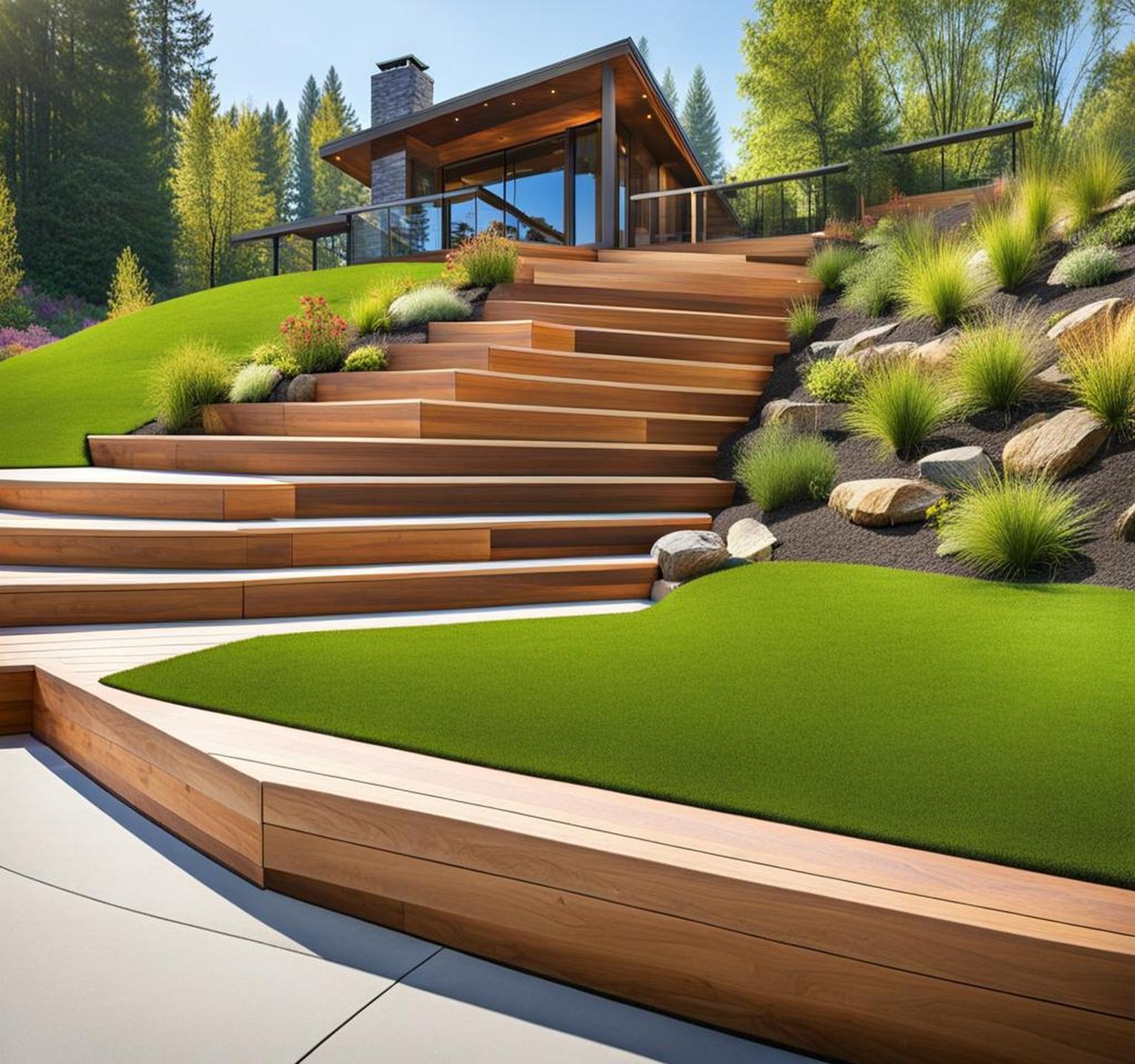Having a backyard with a steep slope can present a range of challenges. But in many cases, it is possible to modify the slope to make the space more usable and pleasant with clever landscaping, terracing, and thoughtful design elements.
You’ll find a range of techniques for erosion control, water runoff management, tiered planting, maximizing views, creating functional spaces, and enhancing beauty.
Assess the Slope and Drainage
Getting familiar with the specifics of your sloped backyard is the critical first step. Study the layout and topography to identify particular trouble spots or ultra-steep areas. Evaluate how water drains across the slope during heavy rains to plan your drainage approach. If you are unsure about taking on major grading or drainage projects, consultation from a professional landscaping company can provide valuable insight.
Stabilize the Slope
Preventing further soil erosion is pivotal for sloped backyards. Installing retaining walls can not only create useful flat zones but also secure loose soil on steeper banks. Utiliing native deep-rooted plants like shrubs, grasses, and groundcovers will also stabilize soil effectively through their dense root structures.
Other helpful erosion control techniques include:
- Hydroseeding – spraying a slurry of grass seeds and mulch
- Silt fencing – woven synthetic barriers to filter sediment
- Jute netting – biodegradable fiber blanket securing loose materials
Control Water Runoff
Managing drainage is crucial on hilly terrain to prevent ravines caused by rushing water or flooded areas at the base of the slope. Installing French drains, which are trenches filled with gravel, can divert flowing water underground. These drain pipes route water away from the slope surface.
Other options to safely channel runoff include:
- Rain gardens – shallow, dug-out zones planted with water-tolerant vegetation
- Dry creek beds – ditches filled with rocks that mimic natural drainage routes
Tier the Landscape
It can be difficult for plants to take root on excessively steep ground. Creating multiple terraced levels transforms unusable angled space into practical garden beds or patios. Graduated plantings cascade beautifully down the slope, while short retaining walls reinforce the separate tiers.

Linking these leveled spaces with steps and pathways also improves backyard accessibility and functionality. This terraced landscaping helps control erosion as well.
Embrace the Slope
Sometimes it pays to work with the natural topography rather than attempting to correct it. Kids love adventure playgrounds and slopes naturally suit slides, swings, and climbing structures with minimal site preparation needed. Uphill hammocks, hillside swings, and leaning lounge chairs similarly embrace the angle of incline.
Rock gardens and alpine plants also thrive on the free drainage offered by slopes. You can craft beautiful cascading designs that incorporade the vertical dimension.
Sculpt the Terrain
| For especially problematic areas, consider selectively reshaping overly steep banks for greater usability. This may involve cutting back the slope or building up flattened mound areas with imported fill dirt. Balance any soil removal by distributing it to fill uneven spots nearby. |
Earth-moving equipment can efficiently carry out this customized contouring to sculpt well-graded banks, usable yards, and interesting elevated outlooks or berms from awkward sloped land.
Get Creative with Hardscaping
Slopes don’t have to limit patio or deck installations. Decks can utilize unexpected angles and shapes for an avant-garde appearance, while patio builders may offer tiered or curved designs. Fences stepping down the incline provide enclosure and height variations add architectural interest.
Get innovative with zig-zagging borders, aggregate or stone mosaic patterns following the land contours, and mixed hardscape materials like brick/stone combinations.
Take Advantage of Views
One excellent advantage sloping properties offer is expanded views over surrounding scenery. Frame vistas of landscapes beyond by selective clearing or pruning. Open up downhill sightlines by removing lower-growing trees. Then create dedicated observation areas oriented towards the views.
Multi-level decking, distinct garden rooms stepping downwards, and outlook nooks placed at various elevations allow multiple viewing opportunities.
Utilize Leveling Techniques
For usable flat yard zones on a slope, importing extra topsoil can effectively achieve a smooth grade. Just ensure drainage accommodations are made so water still flows away from the leveled area. This may mean building up low points elsewhere to create the desired elevated surface.
A laser level helps fine-tune smooth, even grading. Blend any seams with the existing slope subtly so flattened and angled areas coexist naturally.
Pick Slope-Friendly Plants
Choose native plants already adapted to free-draining hillside conditions. Alpine species, succulents, hardy grasses and wildflowers cope admirably through anchoring roots and drought tolerance. Further enhance erosion control via terraced gardens, which step down the slope, as well as raised planting beds running horizontally across.
Add Unique Structures
Arbors, pergolas, pavilions and gazebos lend vertical design interest that complements sloped sites beautifully. These garden structures offer shade or seclusion options as well. Landscape features like stacked stone walls, cascading water displays and stand-alone garden sculptures can also provide striking focal points.
Strategically placed accent lighting illuminates paths and adds drama to the slope’s angles. Lanterns staked into the hillside evoke a lovely ambience for evening enjoyment.
With creative vision, problematic sloping backyards can transform into functional, accessible spaces that take advantage of the distinctive topography. We’ve covered 12 ingenius solutions ranging from terraced landscaping and hillside play zones to view-maximizing design and decorative focal features. Combining suitable plants with structural enhancements attuned to the slope allows you to turn challenging terrain into a scenic backyard showcase.
The keys are customizing earthworks and grading judiciously, planning adequate drainage capacity, and choosing slope-appropriate elements. With the right approach, hilly backyards unlock abundant potential for those seeking innovative landscaping magic.
